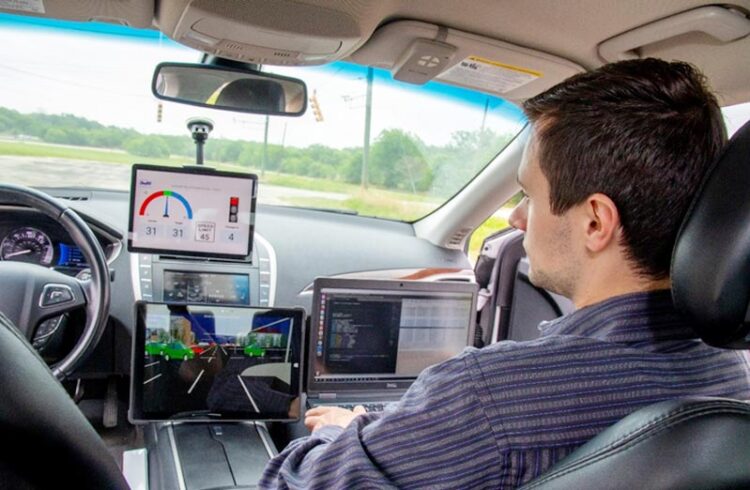Automation, smart driving to increase energy savings

Phase II of SwRI’s ARPA-E NEXTCAR project seeks to increase energy savings to greater than 30% using Level 4 automation technologies. The approach builds on the success of eco-routing, eco-driving and power-split optimization, expanding to explore cooperative control, smart lane change/merge, and dedicated connected and automated vehicle (CAV) operations.
Credit: Southwest Research Institute
NEXTCAR project aims to reduce energy consumption by over 30%.
Southwest Research Institute (SwRI) has embarked on the second phase of an ongoing initiative to develop cutting-edge connected and automated vehicle (CAV) technologies to help passenger vehicles operate more efficiently, reducing energy consumption and emissions.
In 2021, the DOE awarded a three-year, $5.25 million contract to SwRI as part of the Advanced Research Projects Agency-Energy’s (ARPA-E) NEXTCAR program. Having successfully met Phase I requirements, SwRI was one of four teams selected to move on to Phase II, receiving a total $18 million in funding through the NEXTCAR program.
The team is using innovative automation and smart-driving technologies with the goal of improving vehicle efficiency by 30%. The new phase of this U.S. Department of Energy-funded project is led by Scott R. Hotz, director in the SwRI Automotive Propulsion Systems Department, and Sankar Rengarajan, manager in the SwRI Automotive Propulsion Systems department.
Phase I developed R&D 100 award-winning eco-mobility technology using CAV technologies for use in all vehicle classes, including cars, trucks and buses. The team developed a suite of algorithms that reduced fuel consumption by more than 20% under real-world driving conditions. The technology was demonstrated on a commercial electric vehicle and did not change its powertrain or compromise current emissions, safety or drivability.
“For Phase II, our team is leveraging Level 4 vehicle automation, where the vehicle drives itself, and other smart-driving technologies,” said Hotz. “We are building upon our previous technology and successes as we enter this exciting phase of the project.”
After completing the first year of Phase II, Hotz and Rengarajan shared their findings from initial infrastructure and simulation studies at the 2022 ARPA-E summit in Detroit. The team used a specialized virtual-traffic-enabled test to validate simulation data for their Phase II concepts, highlighting the future potential of SwRI’s “connected powertrain” concept. This concept improved efficiency via vehicle-to-vehicle (V2V) and vehicle-to-infrastructure (V2I) communications to optimize routes and speeds.
The team is outfitting the current development vehicle, a Honda Clarity plug-in hybrid, with SwRI’s specialized drive-by-wire, perception and planning technologies. A 17-kWh battery pack and on-board dedicated short-range radio enables the V2V and V21 communications.
Phase II builds upon the success of SwRI’s eco-routing, eco-driving and power-split optimization concepts — the combined technologies and algorithms that enabled the 20% savings in Phase I. The team will now explore cooperative control between groups of connected vehicles, smart lane changing and merging without human influence, and dedicated CAV operations designed to enhance a vehicle’s situational awareness and overall V2V and V2I communication.
In the latter part of this three-year development phase, the team will explore applying the technology in fleets and long-haul trucks. The team is seeking fleet collaborators to assist in deployment.
As a leader in automotive engineering and intelligent systems, SwRI has several ongoing research initiatives to improve the efficiency and range of hybrid and electric vehicles in addition to lowering emissions of internal combustion engine vehicles.
The “Eco-Mobility with Connected Powertrains” technology suite is currently available to license. For more information, contact Sankar Rengarajan at +1 210 522 4955.
For more information, visit https://www.swri.org/industry/automotive-software-electronics/connected-powertrain.
Media Contacts
Darlene Herring
Southwest Research Institute
darlene.herring@swri.org
Office: 210-522-5692
Jesus Chavez
Southwest Research Institute
jchavez@swri.org
Office: 210-522-2258
All latest news from the category: Automotive Engineering
Automotive Engineering highlights issues related to automobile manufacturing – including vehicle parts and accessories – and the environmental impact and safety of automotive products, production facilities and manufacturing processes.
innovations-report offers stimulating reports and articles on a variety of topics ranging from automobile fuel cells, hybrid technologies, energy saving vehicles and carbon particle filters to engine and brake technologies, driving safety and assistance systems.
Newest articles
Faster, more energy-efficient way to manufacture an industrially important chemical
Zirconium combined with silicon nitride enhances the conversion of propane — present in natural gas — needed to create in-demand plastic, polypropylene. Polypropylene is a common type of plastic found…

Energy planning in Ghana as a role model for the world
Improving the resilience of energy systems in the Global South. What criteria should we use to better plan for resilient energy systems? How do socio-economic, technical and climate change related…

Artificial blood vessels could improve heart bypass outcomes
Artificial blood vessels could improve heart bypass outcomes. 3D-printed blood vessels, which closely mimic the properties of human veins, could transform the treatment of cardiovascular diseases. Strong, flexible, gel-like tubes…





















